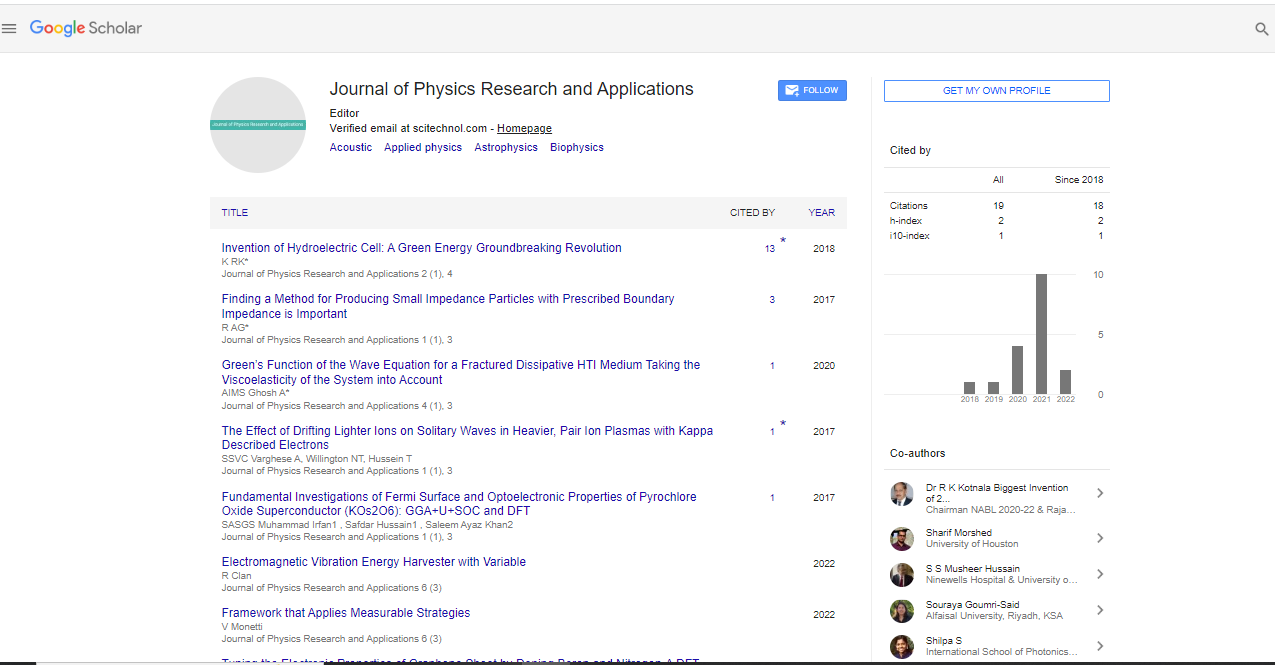Commentary, J Phys Res Appl Vol: 8 Issue: 3
Innovative Photovoltaics: High-Efficiency Technologies for a Sustainable Future
Cheng Peng*
1Department of Physics, Jilin University, Changchun, China
*Corresponding Author: Cheng Peng,
Department of Physics, Jilin University,
Changchun, China
E-mail: 13830943@pen.cn
Received date: 26 August, 2024, Manuscript No. JPRA-24-151960;
Editor assigned date: 28 August, 2024, PreQC No. JPRA-24-151960 (PQ);
Reviewed date: 11 September, 2024, QC No. JPRA-24-151960;
Revised date: 18 September, 2024, Manuscript No. JPRA-24-151960 (R);
Published date: 25 September, 2024 DOI: 10.4172/JPRA.1000112.
Citation: Peng C (2024) Innovative Photovoltaics: High-Efficiency Technologies for a Sustainable Future. J Phys Res Appl 8:3.
Description
The global demand for sustainable energy sources has catapulted Photovoltaic (PV) technology into the spotlight. As concerns about climate change, energy and the depletion of fossil fuel reserves increases, solar energy can be used as alternative. Among the various renewable energy technologies, photovoltaics have a unique position due to their scalability, versatility and the abundance of sunlight. Innovations in PV technology aim to increase efficiency reduce costs and improve sustainability, making solar energy an increasingly viable solution for a better future. Traditional silicon-based PV cells, which suppress the market, have efficiency limitations. Commercially available silicon solar cells typically achieve efficiencies of around 20%-25%. Moreover, the high energy and resource costs associated with the manufacturing of these cells pose sustainability challenges. Innovations in materials, cell architecture and manufacturing processes are essential to overcome these limitations and unlock the full potential of solar energy. Perovskite Solar Cells (PSCs) have emerged as a revolutionary technology in photovoltaics, named after their unique crystalline structure, perovskites are inexpensive to produce and offer exceptional light absorption properties. Laboratory tests have shown that perovskite cells can achieve efficiencies exceeding 25%, rivaling traditional silicon cells. Additionally, they are lightweight and flexible, making them suitable for a wide range of applications, including portable devices and Building-Integrated Photovoltaics (BIPV).
Researchers are actively exploring lead-free alternatives and encapsulation techniques to enhance the durability and environmental safety of perovskite cells. Tandem solar cells combine multiple layers of photovoltaic materials to capture a broader spectrum of sunlight. By stacking a high-efficiency material like perovskite on top of a traditional silicon layer, tandem cells can achieve efficiencies surpassing 30%. This layered design allows the top cell to absorb high-energy photons while the bottom cell captures lower-energy photons, optimizing energy conversion.
Quantum dots are nanoscale semiconductor particles that exhibit unique optical and electronic properties. When used in solar cells, they offer tunable bandgaps, enabling precise control over the wavelengths of light absorbed. Quantum dot solar cells hold the potential for high efficiency, lightweight design and flexibility. Current research focuses on improving the stability and scalability of quantum dot technology. These cells are particularly attractive for applications in transparent solar panels, wearable electronics and low-light environments. Bifacial solar panels are designed to capture sunlight on both sides of the panel. Unlike traditional monofacial panels, bifacial systems utilize reflected sunlight from surfaces such as rooftops or the ground, increasing overall energy output. This design is particularly effective in regions with high albedo, such as snowy or desert environments. Advancements in anti-reflective coatings and panel design have made bifacial technology more efficient and durable. Combined with tracking systems that adjust the panels angles throughout the day, bifacial solar panels can significantly boost energy production.
Concentrator Photovoltaics use lenses or mirrors to focus sunlight onto small, high-efficiency solar cells. By concentrating sunlight, CPV systems can achieve efficiencies of over 40%. This technology is wellsuited for areas with high direct sunlight, such as arid regions. However, CPV systems require precise tracking mechanisms and are sensitive to diffuse light conditions, limiting their applicability in cloudy or humid environments. Continued innovation in tracking systems and cooling technologies is essential to enhance the viability of CPV systems. While improving efficiency is a primary goal, the sustainability of PV technology is equally essential. The production of solar panels involves energy-intensive processes and the use of rare or hazardous materials. Due to these concerns, researchers are focusing on developing recyclable PV materials and adopting circular economy principles. For example, end-of-life management strategies for solar panels include recycling valuable materials such as silicon, silver and aluminum. Innovations in eco-friendly manufacturing processes, such as low-temperature production methods can further reduce the efficiency of PV technology. Innovative photovoltaics are not just about high-efficiency cells; they are also about intelligent integration with broader energy systems. Smart grids, energy storage solutions and demand-response technologies are essential for maximizing the benefits of solar energy.
 Spanish
Spanish  Chinese
Chinese  Russian
Russian  German
German  French
French  Japanese
Japanese  Portuguese
Portuguese  Hindi
Hindi 
